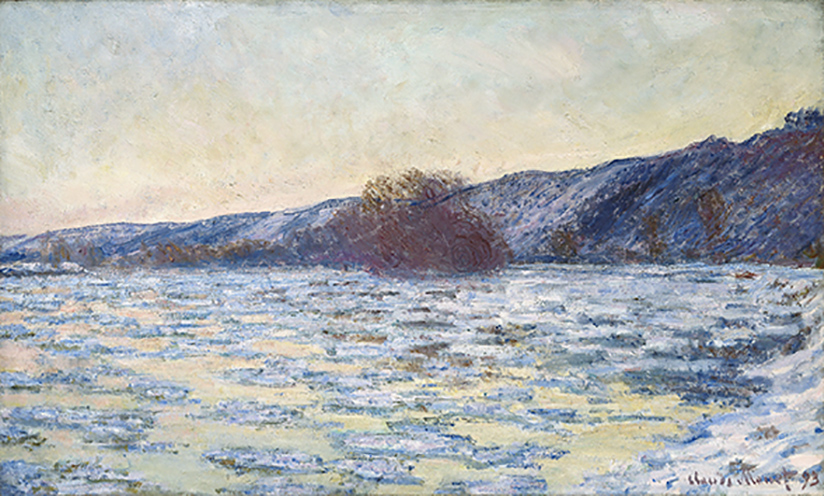The Seine lies still and quiet and wide like a lake, not far from Giverny, the place where Monet had lived since 1890. It is January, and the ice is breaking up. High water levels and the drifting ice are ravaging the banks. Gardens are being submerged, damage is being done, and the water and ice are tearing away everything that they can reach. Monet painted twelve versions of this motif, all depicted from approximately the same vantage point. However, we see not even the slightest trace of a natural drama.
It is clear that Monet was not interested in the natural catastrophe, which he could easily have shown and which offered itself readily as a spectacle and as an exceptional subject matter for a picture.
In this collected peacefulness of water and ice, hills and sky, light and reflections, there sits a small world, a grove, which we are viewing from a distance. Perhaps it does not even deserve the name of “grove”—it is more of a group of trees, a bit of rough scrub. The bare woody forms offer purchase to the gaze as it feels its way over the ice and the reflected light, mediating between the water, the hills, and the skies. When one steps closer, however, it reveals it- self as an astonishing, nervously quivering bundle of lines. No hint of trees or bushes. This structure has been roughly applied with energetic brushstrokes, and its tumultuous dynamic is the precise opposite of the quiet currents of the Seine, which appear to have almost come to a halt.
So, what is the reason for this nervous quality, this unrest, this bundle of dis- trait strokes? Seen close, one could not possibly mistake them for trees, even with the best will in the world. Let us take this unrest as it is, accept that which constitutes it, and observe what it evokes: once more, it evokes astonishment at the painterly distance of the Impressionists from nature—that nature that was so important to them—and their remarkable abstraction. This also applies to the ice floes; their rich and sparkling color anticipates the water lilies of later years. And, if the maelstrom of the “wood” threatens to become overwhelming, one only has to take a few steps back, causing this hectic bun- dle to transform again into a group of sedate trees.
Or could this be the work of the Browns’ three sons in an unsupervised moment— an overpainting of a picture avant la lettre, decades before Arnulf Rainer? This picture entered the collection in 1910, when Sidney Jr., John, and Harry were twelve, ten, and five years old . . . just the age for such a trick.
Markus Stegmann in: «Herzkammer», Museum Langmatt 2020
